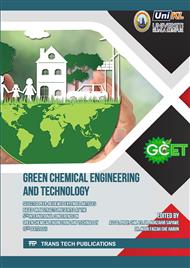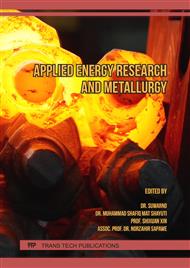[1]
U.S. Geological Survey, Mineral Commodities Summaries,, Miner. Commod. Summ., p.202, (2016).
Google Scholar
[2]
United Nation Statistic Division, United Nations Statistics Division - Commodity Trade Statistics Database (COMTRADE),, 2017.
Google Scholar
[3]
H. Muttashar, N. Ali, A. Ariffin, and W. Hussin, Microstructures and physical properties of waste garnets as a promising construction materials,, Case Stud. Constr. Mater., vol. 8, no. June, p.87–96, (2018).
DOI: 10.1016/j.cscm.2017.12.001
Google Scholar
[4]
D. Olson, Industrial Garnet,, Min. Eng., vol. 58, no. 6, p.37, (2006).
Google Scholar
[5]
G. James and R. Phillip, U.S. industrial garnet. Reston, USA: U.S. Dept. of the Interior, U.S. Geological Survey, (2006).
Google Scholar
[6]
U.S. Geological Survey, Mineral Commodity Summaries. (2018).
Google Scholar
[7]
US EPA, A Citizen's Guide to Solidification and Stabilization,, US EPA, 2012. [Online]. Available: https://www.epa.gov/remedytech/citizens-guide-solidification-and-stabilization.
Google Scholar
[8]
A. Al-Tabbaa, Reactive magnesia cement,, in Eco-Efficient Concrete, Woodhead Publishing Limited, 2013, p.523–543.
DOI: 10.1533/9780857098993.4.523
Google Scholar
[9]
S. Iyengar and A. Al-Tabbaa, Application of Two Novel Magnesia-Based Cements in the Stabilization/Solidification of Contaminated Soils,, in GeoCongress 2008 : Geotechnics of Waste Management and Remediation, 2008, p.716–723.
DOI: 10.1061/40970(309)90
Google Scholar
[10]
H. Muttashar, A. Ariffin, N. Hussein, W. Hussin, and S. Ishaq, Self-compacting geopolymer concrete with spend garnet as sand replacement Self-compacting geopolymer concrete with spend garnet as sand replacement,, J. Build. Eng., vol. 15, no. October, p.85–94, (2017).
DOI: 10.1016/j.jobe.2017.10.007
Google Scholar
[11]
G. C. Bye, Portland Cement: Composition, Production and Properties. Thomas Telford, (1999).
Google Scholar
[12]
S. Gauffinet-Garrault, The Rheology of Cement During Setting,, in Understanding the Rheology of Concrete, 2012, p.96–113.
DOI: 10.1533/9780857095282.1.96
Google Scholar
[13]
J. Bhatty, Hydration versus strength in a Portland Cement Developed From Domestic Mineral Wastes - A Comparative Study,, Thermochim. Acta, vol. 106, p.93–103, (1986).
DOI: 10.1016/0040-6031(86)85120-6
Google Scholar
[14]
R. Gabrovšek, T. Vuk, and V. Kaučič, Evaluation of the hydration of Portland cement containing various carbonates by means of thermal analysis,, Acta Chim. Slov., vol. 53, no. 2, p.159–165, (2006).
Google Scholar
[15]
X. Li, Y. Lv, B. Ma, W. Wang, and S. Jian, Decomposition kinetic characteristics of calcium carbonate containing organic acids by TGA,, Arab. J. Chem., vol. 10, pp. S2534–S2538, (2017).
DOI: 10.1016/j.arabjc.2013.09.026
Google Scholar
[16]
I. Pane and W. Hansen, Investigation of blended cement hydration by isothermal calorimetry and thermal analysis,, Cem. Concr. Res., vol. 35, p.1155–1164, (2005).
DOI: 10.1016/j.cemconres.2004.10.027
Google Scholar
[17]
T. Matschei, B. Lothenbach, and F. Glasser, The role of calcium carbonate in cement hydration,, Cem. Concr. Res., vol. 37, no. 4, p.551–558, (2007).
DOI: 10.1016/j.cemconres.2006.10.013
Google Scholar
[18]
Y. Qu, Y. Yang, Z. Zou, C. Zeilstra, K. Meijer, and R. Boom, Thermal decomposition behaviour of fine iron ore particles,, ISIJ Int., vol. 54, no. 10, p.2196–2205, (2014).
DOI: 10.2355/isijinternational.54.2196
Google Scholar
[19]
A. M. Neville, Properties of Concrete, 5th ed. Harlow, England: Pearson, (2011).
Google Scholar
[20]
P. A. M. Basheer, D. P. Russell, and G. I. B. Rankin, Design of concrete to resist carbonation,, Durab. Build. Mater. Components 8, Vols 1-4, Proc., p.423–435, (1999).
Google Scholar
[21]
B. Lagerblad, Carbon dioxide uptake during concrete life cycle – State of the art,, Stockholm, (2005).
Google Scholar



